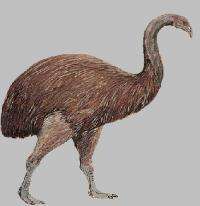February 22, 2010 report
Flightless birds gave up flying after dinosaurs were wiped out

(PhysOrg.com) -- Scientists have assumed the ancestors of modern flightless birds were also flightless, but results of new research suggests they only became flightless and began to explore the ground when it became safe to do so because the dinosaurs had been wiped out.
According to the leader of the study, evolutionary biologist Dr Matthew Phillips from the Australian National University in Canberra, when the dinosaurs suddenly became extinct around 65 million years ago, this opened up niches on the ground that were plentiful in food and free of predators. Since there was no need to take to the air for a quick escape, the birds, such as the ancestors of modern day ostriches, cassowaries, rheas and emus, stayed on the ground and grew fat, until they could no longer fly.
Dr Phillips said it was an advantage to the birds to lose the ability to fly because wings are “fairly costly in terms of the amount of energy that goes into them.” Becoming larger was also of benefit because it made them more energy efficient.
Phillips and his team studied fossil DNA of flightless birds, including the extinct giant moa, from what is now called New Zealand, and other ancestors of the modern large flightless birds. They discovered the moa’s closest relatives were small ground-dwelling birds called tinamous, which are still found in South America today, and which can just barely fly. Molecular dating of the samples suggested the ancestors of the moas became flightless around the same time the dinosaurs became extinct. Phillips said the extinction of the dinosaurs had effects on birds that were previously unknown, and was a turning point in the evolution of the modern birds.
During the period in which the moa’s ancestors lived, the Cretaceous (about 145 to 65 million years ago), Antarctica, New Zealand, Australia, Africa and South America were joined together as the massive super-continent Gondwana. Over time the segments began to drift apart, with New Zealand separating from Gondwana around 80 million years ago.
The new study suggests the flightless birds evolved separately from flying ancestors on the different land masses, rather than from a single flightless ancestor on Gondwanaland, as previously thought, and they all lost the ability to fly about 65 million years ago. This neatly solves the age-old problem of how “flightless” birds could have reached the different continents: they were not flightless at all, and simply flew.
The results of the study are published in January’s edition of the Systematic Biology journal.
More information: Tinamous and Moa Flock Together: Mitochondrial Genome Sequence Analysis Reveals Independent Losses of Flight among Ratites, Systematic Biology 2010 59(1):90-107; doi:10.1093/sysbio/syp079
© 2010 PhysOrg.com



















